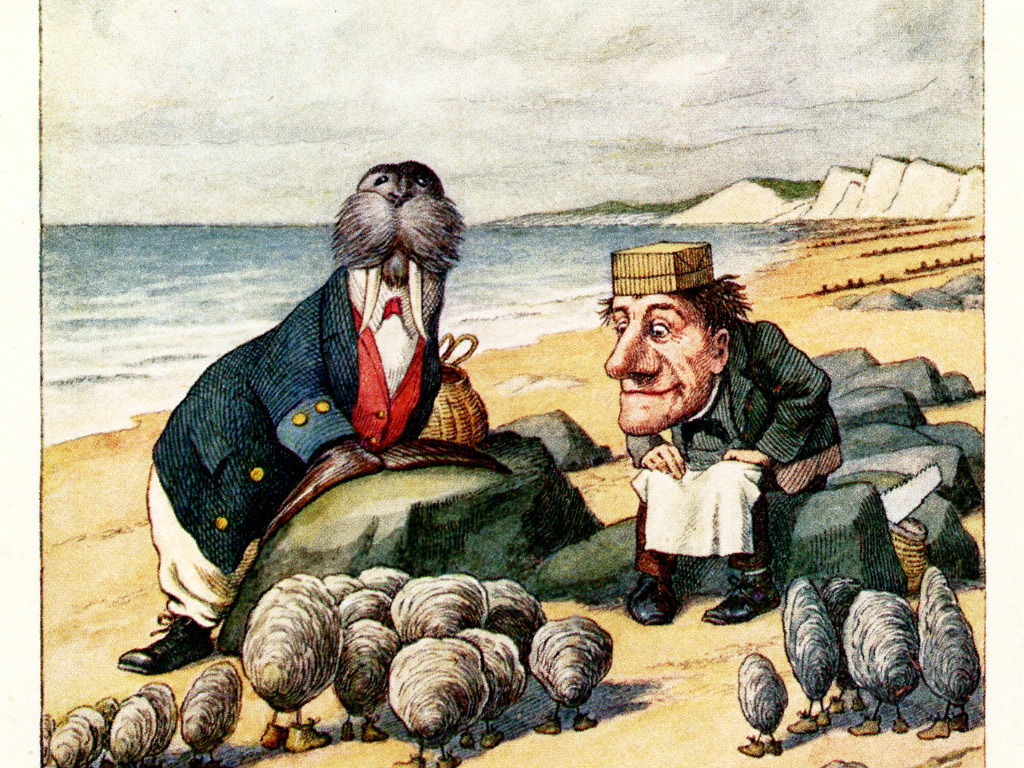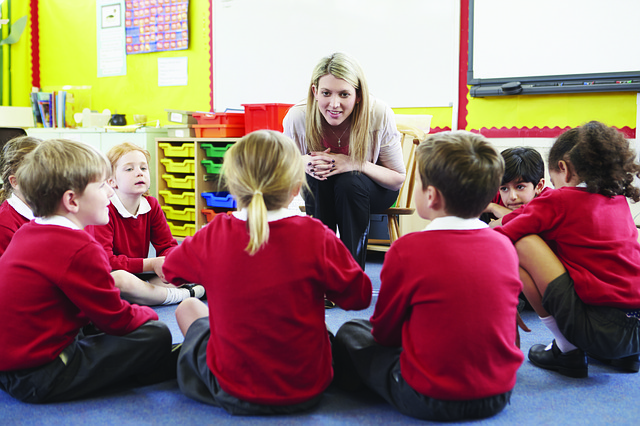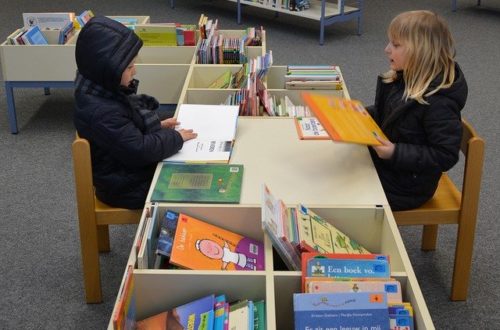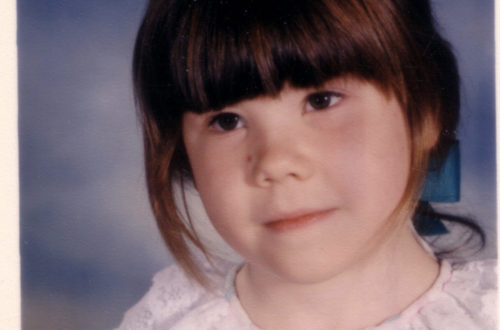A Child is Not a Mollusk. That sounds like a really enticing Lewis Carroll poem—I’d half expect a walrus to come waddling into that title, or maybe a march hare. I’m here to bring up the constructivist Walrus in the room or, rather, in the classroom. We all learn about the theoretical work of Jean Piaget in psychology 101. Biologist, epistemologist, and darling of developmental psychology. Piaget’s work, though not intended as a pedagogy, has come to influence thousands of schools around the world. The idea of a traditional school experience, at least in the United states, has been bound to the theory of Constructivism, which comes in part from interpretations of Piaget’s work.
I’ve written before about my own experience in first grade in the heyday of Whole Language, one of the iterations of Constructivism. This was before they re-marketed themselves as Balanced Literacy—in programs such as Fountas and Pinnell and Reading Recovery. I spent a good chunk of first grade in my “joyful” classroom, where we collected frogs and walked around a historic town, as a functionally illiterate six-year-old. I received a structured literacy intervention in the form of Wilson, and later Reading Mastery by Siegfried Engelmann. I was a reader within three months once someone taught me the code, but I remember very well being a struggling reader in class. It did not feel good. These constructivist practices based on the likes of Piaget’s theories, and the work of Soviet psychologist Lev Vygotsky, are still very much a part of the fabric of our educational landscape.
Vygotsky stressed that socialization is key to cognition, and believed strongly that community plays a central role in the process of making meaning. Piaget’s theory of constructivism argued that people produce knowledge and form meaning based on their experiences. Both Piaget and Vygotsky’s theories had to do with child development, not an actual pedagogy, and that’s a key distinction. The two men do differ in that Piaget believed that a child’s development must precede their learning, while Vygotsky argued that learning is an important part of the process of developing psychological functionality. What has ended up materializing from the theoretical work of both psychologists, is a series of connected practices in teaching that stress reading as a social skill (hence the intense preoccupation with group work) and a belief that foundational reading skills should not take priority over the socialization, and the meaning-making, of the child.
E. D. Hirsch, a professor emeritus of education and humanities at the University of Virginia, notes in The Knowledge Deficit how truly tragic it is that “an army of American educators and reading specialists are fundamentally wrong in their ideas about education and especially about reading comprehension. Their well-intentioned yet mistaken views are the significant reason (more than other constantly blamed factors, even poverty) that many of our children are not attaining proficiency, thus crippling their later schooling.” Hirsch, whose specialty is the history of ideas, was able to delve into what he referred to as this “curse of Romantic Ideas,” these theories that have taken hold and that have shaped our educational landscape, using lofty language and ideals, for the worse.
It’s interesting that we’ve reached this point where thinkers like Piaget, who was originally a biologist who studied mollusks before studying the behavior of his own children, and Vygotsky, who established the disputed theory of the zone of proximal development, have become the guiding voices of how we teach our children essential skills like reading and writing and basic arithmetic. Both men, who were born in the late 1800s and who developed their theories in the early 1900s without any peer review or comparative studies or basic modern scientific means, have shaped many generations of students. The problem goes even farther back to the Romantic Revolution of the 1800s.
Hirsch explains that “our nation was born in the Enlightenment but bred in the Romantic period,” and that this American Romanticism is really “complacent faith in the benefits of nature.” We can see this adherence to these powerful and influential roots in reading instruction. If reading is a social skill, and children will develop skills naturally by simply working with skilled (or, as it may be, unskilled) companions, then there’s no need to teach phonological awareness skills or decoding or fluency.
As Hirsch relays, the devotion to the “natural,” a revolution that began in the 1800s with thinkers like Thoreau and Emerson, really places our practices more in the realm of belief than in fact. Horace Mann, the father of the American public school system, believed in whole word instruction over sounding out words because “romantic ideas, especially the idea that nature is best, influenced his belief that the best way to teach early reading [was whole language]….those who formed our current ways of approaching education and many other matters, believed that the natural cannot lead us astray.” Because Romanticism is directly tied to the divine, this belief very much means that faith tends to take precedence over the observable empirical evidence of what we see before us in our schools.
If I may introduce one more thread into the mix, we cannot talk about modern day Constructivism in our classrooms without also discussing the role of the Social Gospel movement, which began to take hold around the same time Piaget and Vygotsky were devising their theories on child development, and the Transcendentalists were leading the Romantic movement in the United States. There’s a reason our education system relies so heavily on faith. I am not talking about faith in a divine power, but faith in this natural ability of the child to learn and problem solve on their own that constructivists cling to. This faith explains a great deal about why education reform is so difficult to achieve, and why the teaching of foundational skills is seen as blasphemy against the untouched perfection of the natural curiosity of the child, rather than as tools for the child to begin the process of discovering.
The Social Gospel, a movement that grew out of the intense and often negative repercussions of the urban industrialization of the post-Civil War period, became the religious arm of the effort to reform the failings of ‘Gilded Age’ capitalism—including education. The Gospel, which was delivered from a variety of religious pulpits, took its message to the people in an effort to remedy various social problems such as alcoholism, poverty, child labor, and to create a more just and equal society. However, the good generated by this Progressive agenda also had a downside.
The Social Gospel invariably led to the idea of societal salvation, or the idea that faith must be used to reform and indeedtransform social structures. Enter education, which was seen as a means to bring about the desired perfection and salvation.
What does a group of interfaith ministers, two developmental psychologists, Romanticism, and instruction in our schools have in common? Faith, the conduit of Romanticism, which in turn opened the door to the notion that the natural is divine. Therefore, the natural child, who can learn if only they are placed in the right environment with the right caring adult, is the desired outcome of these pre-World War II theories and movements that shaped society and our education system. Today, education continues to be cast as an instrument for uplifiting and transforming with the teacher frequently cast in the role of “savior” (for example in the film Stand and Deliver), and “good” teachers portrayed as those who encourage students to become their “authentic” selves (as in The Dead Poets Society) rather than conform to the arbitrary and artificial confines imposed on them by the adult world.
What is Constructivism if not faith in the natural child to learn and grow and become a socially conscious member of society? Butin order to build this just and equal society, we must have a citizenry that is capable of occupying such a world. As is true for any Romantic idea, there’s a tendency to rely too heavily on what we want to be true, rather than what is true. It’s no bad thing to envision and work toward a better world, but these ideas have also been stretched to the point of absurdity, creating an education system that relies almost completely on faith and wishful thinking.
Transcendentalism is more appealing, and more elevating, than the idea that reading and writing is a neurobiological process. Under constructivism, children will simply problem-solve their way to understanding these artificial skills. It’s certainly a relief for the teacher who needn’t bother teaching grammar, syntax, spelling, or decoding when these children will develop skills through spontaneous generation perhaps, or simply through osmosis from standing next to a bookshelf or a fluent reader. As E.D. Hirsch tells us, this most influential idea in American education manifests itself as “a natural unfolding” that “has small basis in reality when it comes to reading, writing, and arithmetic.” Given current scientific evidence, “the notion that the job of the schools is to foster the natural development of the child is only a half truth.”
I think most people don’t know why certain practices exist in education for the same reason we don’t question why there’s a best man at a wedding or why people are supposed to kiss under mistletoe. Why do we have stations in the early elementary years? Why is the joy level of a classroom used as a measurement tool for a child’s reading ability? Most of us were taught by teachers who were themselves taught by constructivists. No one questions it, it just is. There’s no science or fact or data that can shake the unshakeable faith in the natural child who needs a guide and not an instructor. Indeed, the whole point is that the outcomes of these beliefs cannot be measured—classification and categorization being hallmarks of the Enlightenment and thus antithetical to the Romantic commitment to holistic learning.
The irony here is that the myth of American schools being stuck in the nineteenth century is in fact true in some ways, but not in the ones fixed in the popular imagination. Rather than being seated stock still at desks arranged in neat rows, with the teacher at the front of the class droning on (for hours!), children are instead seated around tables (or increasingly plunked in front of electronic devices) and left to more or less educate themselves lest the teacher sully their natural curiosity by instructing them directly.
No doubt these educators believe that they are there to support a natural unfolding from a safe distance, because why should a skill like reading or writing be any different than a child learning to walk or talk? This is what educators do when, as Hirsch says, they “extend trust in natural unfolding and delay teaching the mechanics of reading until a child reaches a state that is deemed to be a developmental stage of ‘reading readiness.'”
We certainly do have a lot of kids who can’t read under this dominant theoretical framework, though—thousands upon thousands of them.
We know now how to teach reading. We know what order the various skills need to be introduced, we have programming to effectively train children to be able to read, and then move on to higher order thinking and academic skills when they will have the skills to be independent explorers. Casting them off without those skills would be like trying to teach a small child to swim without a life jacket. We have the research and the knowledge, and yet none of it enters the classroom dominated by constructivism. There is no science or research or empirical data to support the use of constructivist theories and pedagogy.
And yet, figures such as Lucy Calkins, Jo Boaler, and Irene Fountas are hugely influential, and their programs are in practically every school in America. Their belief that a knowledgeable teacher can simply perform miracles, and that through sheer joy and positivity and minimal guidance a child can learn to read and write, is not based in reality.
Reading is a neurobiological process. The joy, the love, the meaning-making that teachers talk about can only occur if a child can in fact read. If you’ve ever tried working with a struggling reader or writer, they don’t tend to enjoy the task very much no matter how good a relationship they have with their teacher. Friendship is an essential ingredient in life, but it has no effect on whether one can make sense of print. That makes about as much sense as the theory of spontaneous generation before Pasteur made his discoveries in the field of microbiology. Milk doesn’t become pasteurized all by itself. Our universe is one of cause and effect, and the effect of not teaching reading properly at a young age means a child will read as slowly as one of Piaget’s 60,000 pet mollusks. All the joy in the world can’t magically produce foundational skills.
Hirsch refers to this misguided belief in natural learning as the “romantic complacency of American educational thought,” and that the belief is that, “given time, [children] will develop a readiness to understand place value in arithmetic…or the phonic code.”
As an avid reader of Romantic literature myself, none of this is to say that a classroom has to be a mausoleum of joyless totalitarianism, which is how supposedly progressive-minded constructivists staunchly insist on painting schools that emphasize explicit, systematic instruction. It is far more traumatizing to be a child in a classroom unable to read. I can safely say that there is no joy in feeling like reading is impossible, and being in a world where text is everywhere with no way to access the code. Romanticism provides an important counterweight to what might otherwise become an arid, rigidly technocratic approach to life, but it shouldn’t be permitted to hold sway over educational decisions that have lifelong economic, social, and psychological consequences for millions of children—not to mention the society that finds itself with half its citizens reading at or below a fifth-grade level. The political repercussions for that have been staggering.
You could also think of it this way: if I had continued to be educated under the assumption I would naturally gain literacy skills, I wouldn’t have been able to write this blog post.
Today, as Hirsch observes, “our schools and colleges of education, the inheritors of these ideas, are still the nerve centers of an anti-intellectual tradition,” and that one of their most effective rhetorical tools is “to identify the acquisition of broad knowledge with ‘rote learning’ of ‘mere facts.'” Hirsch goes on to explain that, for American educators, “unless school knowledge is connected to ‘real life’ in a ‘hands-on’ way, it is unnatural and dead; it is ‘rote’ and ‘meaningless.'” Never-mind that the key to comprehension is the acquisition of knowledge, of what is considered by constructivists to be rote, and that foundational skill-acquisition is equally essential. None of this matters to the Romantic-minded educator, for fear it will corrupt the divinity of the unspoiled, natural child.
Children are not, however, like mollusks. We as humans don’t have the luxury of living in a shell and not being able to read. Now, the work of Piaget and Vygotsky, in and of itself, is not bad or harmful or wrong necessarily. Though they did not have access to the modern scientific tools we do now, both men were keen observers of behavior, and, as a reading tutor I can appreciate that. Whether or not their theories hold up is not for me to say. I’m not a psychologist or an expert on their theories.
However, what I have observed, and what I can see in the students who come to me, is the profound harm the pedagogical interpretation of these theories has wrought under the auspices of progressive joyful teaching of “the whole child.” The notion that reading is natural, that a child is this seperate entity from their foundational skills, is not in keeping with what we know to be true about how children acquire basic skills.
Most of us are born as social creatures, but we are not born understanding ancient Phoenician symbols on an intrinsic level. Constructivism has seeped into almost every corner of the educational world, and later on in school, if those foundational skills are in place, there is a role for discovery and inquiry-based learning. It’s very hard for a learner who can’t decode words or fluently read to engage in projects or participate fully in a classroom. All children can make meaning, but without the proper teaching, not all children can make meaning from text. In some sense, without evidence-based instruction, a child could be more like a mollusk in that they will withdraw from the learning process and build a shell to protect themselves from the emotional anguish of feeling less-than in the classroom.
Hirsch, E. D. (Eric Donald), 1928-. The Knowledge Deficit : Closing the Shocking Education Gap for American Children. Boston :Houghton Mifflin, 2006.
H. Evans Professor of the History of Christianity, Christopher. “How the Social Gospel Movement Explains the Roots of Today’s Religious Left.” The Conversation, 1 July 2020, theconversation.com/how-the-social-gospel-movement-explains-the-roots-of-todays-religious-left-78895.






One Comment
Ben Tobin
Thank you so much! Glad to connect with you!